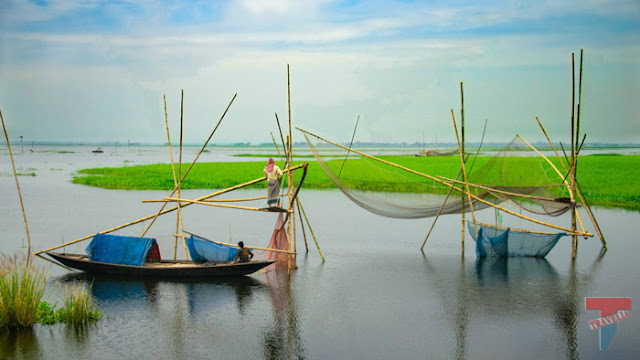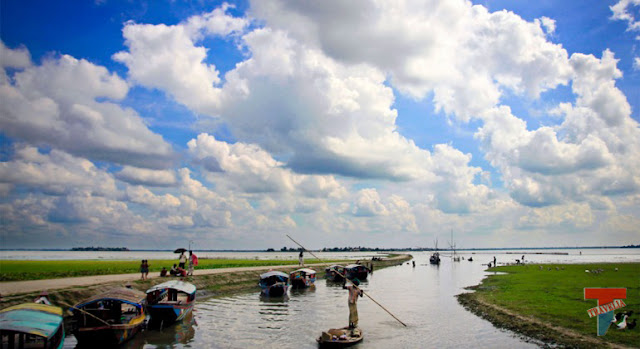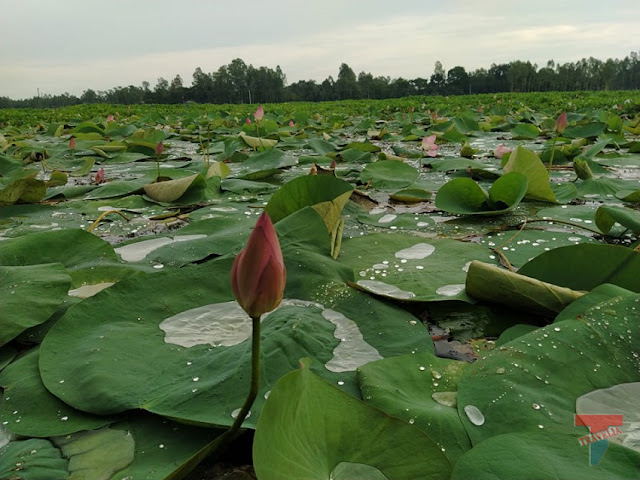Chalan Beel
It was probably a backwater wetland until it turned into a lake. The formation of the challan bill is historically related to the contraction of the Atrai and Baral rivers. The river Atrai was the main supply system of the Chalon Beel which drained the northern part of Rajshahi district and Dinajpur area. The Baral Chalan acts as a drainage ditch from the beel and carries the water of the beel to the river Jamuna. At the time of formation, the area of Chalon Bill was about 1,07 sq km. Adjacent to the southern end of the Chalon beel is the Gumni river which carries the water of the beel and first throws it into the big beel and finally falls into the Jamuna. As the water level rises due to the flooding of the Jamuna, Baral retains some of the water and the water in the beel also rises; This water level does not decrease till the water of Jamuna goes down. During the dry season, most of the beel dries up and turns into a water cavity of 25.9 to 31.6 square kilometers, which can be called 'core part' of the beel. This main part, however, is deprived of a continuous supply of water, but rather the sum of a number of shallow reservoirs connected by successive canals. Surrounding this main part are two concentric unequal oval areas where the locally known floating paddy is produced. Currently the challan bill is filling up fast. Due to siltation from the Ganges every year, the bill has moved at least 19.32 km from the south in the last one and a half years.
How to get there:
Chalan Beel, one of the largest beels in Bangladesh and one of the richest wetlands. The largest bill in the country is the sum of many small bills connected by different canals or aquifers. During the monsoons, they all merge into one body of water covering an area of about 36 square kilometers. The bill covers three adjoining districts of Natore, Pabna and Sirajganj. The Chalon Beel covers Raiganj of Sirajganj district and Chatmohar upazila of Pabna district. Besides, three quarters of Tarash police station in Sirajganj district is located in this bill. The southeastern end of the bill extends to Ashtamanisha near Natunnagar in Pabna district. The northern boundary of Chalan Beel in this district is the line drawn from the eastern end of Singra to the river Bhadai which marks the boundary between Natore, Pabna and Bogra districts. Drawing a north-south line along the Tarash Upazila and Pabna District on the east bank of the Bhadai River would be the rough eastern boundary of the bill. The widest part of the bill extends from Tarash in the north-east corner to Narayanpur on the north bank of Gumni river, about 13 km. It is the longest from Singra to Kachikata on the Gumani bank, about 24 kms. When the Brahmaputra River changed its course and turned into the present Jamuna, the Chalan Bill was formed. The abandoned course of the Karatoya and Atrai rivers is a vast expanse through inclusion.
The small bills forming the challan bill are: Piprul, East Madhyanagar, Laro, Dangapara, Tajpur, Niala, Challan, Majhgaon, Brisho, Chonmohan, Shatail, Kharadha, Darikushi, Kazipara, Gajna, Barabil, Sonapatila, Ghughudah, Kurlib, and eternal. Several rivers flow through the Chalon Bill. Notable among these are- Karatoya, Atrai, Gur, Baral, Mara Baral, Tulsi, Vadai, Chiknai, Baronja, Telkupi etc.
The Public Works Department conducted a survey in 1909 to investigate the bill's drainage system and sedimentation, and found that the Chalon Bill had shrunk from its previous 1,085 sq km to 36 sq km. The remaining land has been used for cultivation or settlement. Only 65 sq km of this degraded area has water all year round. The challan bill is filling up quite quickly. Land is being reclaimed and villages are being built along the banks of the bill. With the exception of the deepest part of the center, all the big and small beels dry up in the dry season. Boro and high yielding paddy are cultivated in the dry season in the marginal areas outside the center. Deep water aman paddy is cultivated in shallow marginal areas during monsoon. This challan bill also meets the demand for a lot of fish in North Bengal.
The fare from Dhaka to Natore / Kustia bus will be 360 Tk. Buses are available after 10-15 minutes.
CNG reserve from Kachikata 250-300Tk.
You will get a boat at Bilsa for 150/200 Tk. per hour.
Where to stay and eat:
If you want to see the challan bill of Natore, you have to stay at the district headquarters of Natore. For staying in the city there are VIP Hotel in Chakrampur and Hotel Uttara and Hotel Millat on Madrasa Road. Rent from 300 Tk. to 700 Tk.
You can also eat lunch at Bilsa Bazaar.
On the way, don't forget to try Chachkair Bazar Yogurt and Rasmalai.




